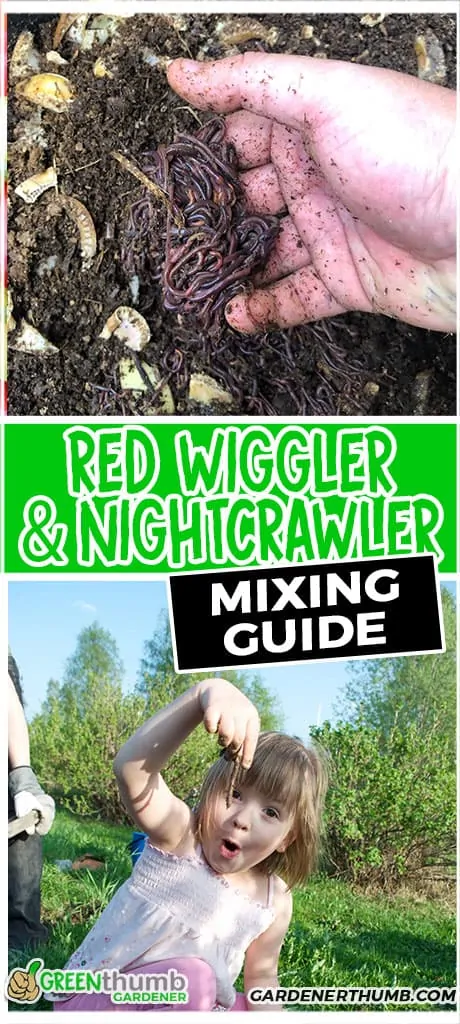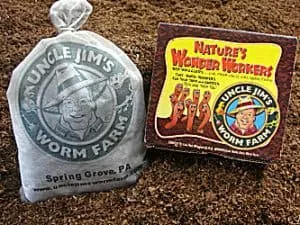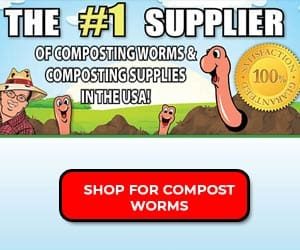Can You Mix Red Wigglers and Nightcrawlers?
Last Updated 9/16/20
Red wigglers and nightcrawlers are two worm species you can use on your farm to maintain and/or increase the fertility of plants’ soil.
You may already know that by now…
But, the question you’d like answered is, “can you mix red wigglers and nightcrawlers?”
Yes, you can. Depending, however, on a number of factors we’re going to be examining in detail later in this article.
So, find a cool spot you can relax to read this…
Green thumb Gardener occasionally links to product and/or services offered by vendors to assist you with all your gardening needs. Some of these may be affiliate links, meaning we earn a small commission if items are purchased.
Want to Download a Garden Hack Guide for FREE

Enter your email below and we will send you a guide to help you SAVE money in your garden.
What are Red Wigglers & Nightcrawlers?
For those of you who have been wondering what red wiggler and nightcrawlers are.
These red worms are just two worm species that you can use for composting your worm farm and worm bin.
These worm species can help in maintaining the health of your plants’ soil, and also in facilitating plants’ growth, as well.
Nightcrawlers | All Around Worm
For those who don’t know what nightcrawlers are, they’re also known as common earthworms or, simply, earthworms (Lumbricus terrestris).
These large red worm species are known to be great diggers.
You even have noticed them a number of times trying to burrow into the soil in your yard after rainstorms.
This is because night crawlers solely depend on the soil for all the nutrients they need to survive.
These composting worms also fancy their solitary underground homes, which is one of the reasons these worm species love to travel down deep into the soil.
As they dig their way through, they eat dirt and, in the process, leave behind what is called “worm castings”.
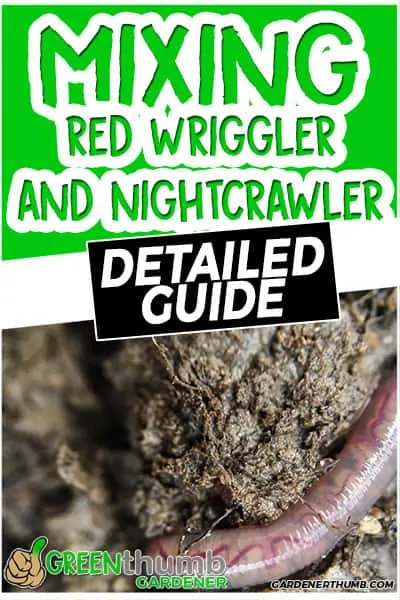
Which can significantly fertilize your farm bin and keep your plants thriving all through the year.
Nightcrawlers make deep burrows that can aerate the soil and allow your plants’ root to properly absorb the oxygen they need to stay healthy and keep growing.
You’ll usually find these worms after a rainstorm or late at night when they come out to mate (which is probably why they were given the name, “nightcrawlers”).
Red Wigglers | Tigers of The Soil
Red wiggler (Eisenia fetida) are otherwise known as red worms or tiger worms. They are similar to earthworms (even categorized as a species of earthworms) with only a few differences in their features.
Compared to regular earthworms, red wiggler are usually tinier and shorter. They also have a reddish-purple hue that distinctly distinguishes them from earthworms.
Below are some of the basic facts that differentiate red worms from common earthworms:
- Red wiggler mainly feed on manure and rotting plant matter.
- They can withstand high temperatures, unlike earthworms.
- They do not burrow deep into the soil as earthworms do.
- You’ll find them closer to the earth’s surface in large groups.
- They reproduce quickly.
Green thumb Gardener occasionally links to product and/or services offered by vendors to assist you with all your gardening needs. Some of these may be affiliate links, meaning we earn a small commission if items are purchased.

Need Red Wriggler Worms?
- Live compost worms ship to your door
- #1 supplier of Composting supplies
- Uncle Jim’s is our source for worms
Earthworms Or Nightcrawlers Help to The Rescue
You might not be aware of some of the benefits that using earthworms and nightcrawlers can be to help your soil. Maybe it is time to get yourself a worm bin.
How can earthworms help your plants?
Contributes to Soil Nutrients
As the earthworms dig through the soil, they feed on dead organic matters or underground composts, and, automatically, convert them into “castings” (waste-like materials they excrete after devouring soil composts), which they release back into the soil.
These composting worm castings are made up of important nutrients (like calcium, phosphorus, magnesium, and nitrogen) that can improve the structure of your plants’ soil.
Soil Aeration & Water Drainage Improvements
These castings can also reduce water drainage, too.
As mentioned earlier, earthworms love solitary, which is why these fascinating creatures can burrow as deep as six inches into the soil to enjoy this solitude.
The deep tunnels they create in the process serve as efficient channels through which oxygen is allowed to flow through to the plants’ root structure.
Increased Plant Growth
The burrows they make also creates a better environment in which the microorganisms can assist in the growth of your plants.
Red Wiggler Worm Benefits For Your Garden
The benefits of red garden worms are similar to that of having earthworms in your garden with only a few differences in the environmental preferences and limits of red worms.
Improve Soil Nutrients
For example, red wigglers prefer to feed on decaying soil matter (like fallen leaves and animal wastes) and manures instead of in-ground composts, as opposed to earthworms.
In this process, they also release castings (as do earthworms, too), which can highly contribute to the nutrients level of your plants soil. This can be also harvested by using a worm bin to help break down kitchen waste.
Increased Oxygen & Air Circulation
Red wigglers cannot dig as deep as earthworms, probably because of their small size and short length, and can be only found within an average of two inches deep into your plants’ manure compost or soil.
However, red worms can also aerate your plants’ soil to allow the easy absorption of water, oxygen, and other necessary nutrients you decide to use in your garden.
Are Worms Good For Gardens?
As you can see, from the benefits mentioned above, worms can be an extremely rich addition to your garden.
As a fully organic indoor gardener, you must understand the importance of naturally maintained fertile soil structure all year round, without having to use toxic chemicals.
This is why you might want to use vermicomposting to better sustain and also increase the soil nutrients your plants depend on for optimal growth.
But, what is vermicomposting? Should you invest in a worm composting bin?
Vermicomposting
Vermicomposting, in simple words, refers to the use of worms, and other microorganisms, to convert dead or decaying organic matter into fertile nutrients for your soil.
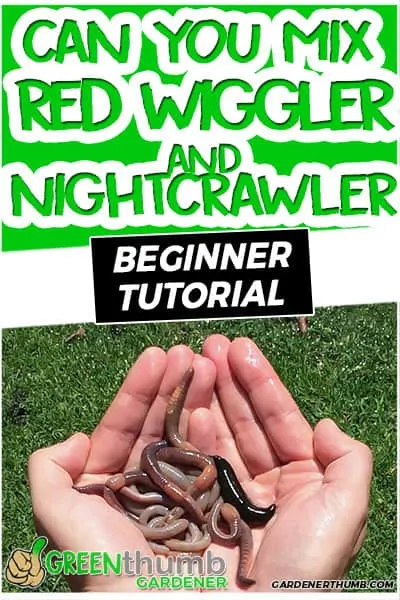
Not just any type of worms, but those that particularly feed on decomposing organic matter as food for their survival.
Interestingly, worms can also help in breaking down the nutritional elements contained in the soil to make it easier for your plants to absorb them for their survival.
Reason Why You Would Mix Species
As mentioned earlier, red wiggler and earthworms differ slightly in their environmental preferences. The conditions under which a red worm may thrive can be a bit different from that under which nightcrawlers can adapt.
Nevertheless, it is still entirely possible for you, as an indoor gardener, to mix them together in your worm bin.
Mixing Species can help in unstable temperature
Red wrigglers and nightcrawlers each have their own temperature preferences.
Nightcrawlers love cooler temperatures (which is why they dig so deep to find it and wouldn’t come out until after it rains) than red worms who prefer slightly warmer temperatures.
So, mixing the species together would result in you having the most efficient system for your worm bin throughout the year.
When the temperature is cooler, you can expect the earthworms to do their job, while, in warmer temperatures, red wigglers can thrive better.
Mixing Species Ensures A More Efficient System
When you mix red worms and common earthworms together, you might want to expect a more efficient vermicomposting system on your farm with each species contributing differently to the growth of your plants.
For example, nightcrawlers will assist with the aeration for your plants’ roots. Their deep digging will also help your garden soil with drainage and water holding.
Red wigglers, on the other hand, will be more efficient in converting fallen leaves into soil nutrients your plants largely thrive on for optimal growth.
3 Reasons Why You Don’t Want To Mix Species
Even though mixed species can be of great value to your farm, having both worms on your farm can still pose some problems, too.
1. Different Growing Conditions
Red wigglers are similar in a lot of things. However, they thrive better in different conditions. Mixing them can cause under the same condition can cause adaptation problems.
Nightcrawlers are deep diggers, while, on the other hand, red wigglers can be found within only a few inches to the soil surface.
This means, one species will be more comfortable than the other depending on the living condition you’re able to create for them in your garden.
2. Reduced Reproduction Rate
Worms are natural self-regulators. When they sense high population density in their habitat, they’d automatically reduce their mating rate to keep their population in check.
So, if you’re going to be mixing these species, you might want to reduce the density on your farm to aid their reproduction.
Since red worms are smaller, they can easily be kept in higher density than their counterparts, earthworms.
3. Added Expensive
Buying both nightcrawlers and red wigglers can be more expensive than just purchasing one of the worm species.
When you also think of the cost of raising both of them together, you might want to opt for one instead of the two.

Further Reading
Top 5 Ways To Keep Nightcrawlers Alive
You may have to integrate some conditions in your garden to keep your nightcrawlers alive and also ensure the sustainable growth of your plants all at the same time.
1. Keep Soil pH Above 4.5
Earthworms dislike acidic soil, especially a soil structure that has a pH level of less than 4.5.
You might want to measure your soil pH level regularly to keep your soil at and above 4.5 at all times. You can also add lime whenever it falls below the line, as lime can substantially increase the soil pH as well as the calcium level of your plants’ soil.
Composting worms, generally, need calcium for survival and the continuous supply of this element will ensure they thrive properly on your farm.
2. Fill Soil with Enough Organic Matter
Earthworm feeds on soil and largely on dead and decaying organic matter. This is why you might want to adequately provide them with such things as plant matter and animal remains to help them, and also help your plant in the process.
3. Limit Use of Toxic Chemicals
Toxic chemicals like fungicides and ammonium sulfate can seriously injure and reduce the number of worms. So, to prevent this, you can reduce, or stop, the use of fertilizers and fungicides that can harm the worms as well as your plants.
4. Regularly Moisturize Soil
Composting worms usually lose about 20% of their body to casting. To help them stay alive, you would need to keep your soil moisturized at all times.
5. Improve Drainage
You might also want to keep your plants’ soil aerated to prevent water-logging and to give your worms the access they need into your soil.
You Can Even Order Worms Online
- Great Composting Worm
- Includes instructions on how to add to your compost bin
- Guaranteed Alive
Final Thoughts
Mixing both species of red worms together can be good and bad at the same time for your worm farm or compost bin. However, whether you choose to mix or not, worms would still remain invaluable to your garden.
You only just have to do the needful: plant your crops, water them regularly, and the worms will do the rest of the job to ensure you have a fruitful farming season.
Related Questions
1. Can you use nightcrawlers for composting?
Yes, you can. In fact, they’re the common worm species used on a worm farm.
2. What is the difference between red wigglers and nightcrawlers?
Red wiggler and nightcrawlers differ in their overall appearance. They also differ, slightly, in their environmental preferences.
3. Are red wigglers the same as earthworms?
No, they’re not. Red wiggler are tinier and shorter red worms, while earthworms are larger in size.
4. Do worms interbreed?
No, worms cannot interbreed.

